
FINISHED SIZES: Square lap quilt: 57½˝ × 57½˝ ♦ King quilt: 92½˝ × 92½˝
Maitland


Maitland square lap quilt, 57½˝ × 57½˝, made by Kathy Allen, quilted by Shannon Ryan-Freeman, 2016
The three sub-patterns of this square lap quilt, made with fabric in the traditional colors, are easily distinguishable against the olive green background. The tiny stripes of the outer color ring give the Maitland tartan its distinctive look.

Maitland king quilt, 92½˝ × 92½˝, made by Kathy Allen, quilted by Shannon Ryan-Freeman, 2016
There are three sub-patterns against a Christmas-green background in this version, but the subtlety of the blue/green merge makes the largest of the sub-patterns almost disappear into the background, with the blue blocks seeming to appear from nowhere. Although, it is doubtful that anything would be noticed in this quilt other than the thin, bright color ring which gives the Maitland tartan its distinctive look.
The Maitlands are a lowland Scottish clan who originated in Normandy and traveled to Northumberland with William the Conqueror. The name, originally spelled Mautalent, means “foul-tempered” or “evil genius” in old French. (The men of those days wore their nicknames with pride!)
Thirlestane Castle is the historic seat of the chiefs (and later, earls) of Clan Maitland. During the Jacobite battle of 1745, Charles Stuart, who the Scots considered the rightful heir to the throne, stayed at Thirlestane Castle and had his army pitch their tents on the castle parklands. The Maitlands were considered neutral in the Jacobite wars, and so the English allowed them to keep their lands. A couple of hundred years later during World War II, Field Marshal Sir Henry Maitland Wilson commanded in the Middle East and succeeded U.S. General Dwight Eisenhower as supreme Allied commander.
The Maitland tartan, a beautiful pattern dominated by blue and green, has several tiny stripes that give the overall design a real pop. The Maitland tartan is actually a modification of the Lauder tartan, which is similar but doesn’t have the thin yellow stripes.
In this loose interpretation of the Maitland tartan, the large, subtle stripes of blue against a green background are surrounded with dominant black stripes. The pattern will show best if the merge fabrics F and L are dark compared to the base fabrics A and E. The thin stripes give this quilt its dramatic effect (and why, along with having fifteen fabrics, its skill level is designated as experienced).

Fabric Selection To make the thin stripes of the color ring stand out, I suggest that fabrics C, D, G, H, J, K, M, N, and O be tone-on-tone or a solid, and that fabrics C, D, G, and H be a lighter value than fabrics E, I, L, O, K, H, and M. Personally, I like to choose warm zinger fabrics for C, D, G, and H because they give the quilt a real pop against the cool colors of A, E, F, and L!

A single woven pattern in my interpretation of the Maitland tartan. The green background (fabric E) is intersected by base colors black (fabric B) and blue (fabric A), creating the two large patterns. The third pattern, a bright color ring, is created with base fabrics yellow (fabric C), blue (fabric A), and red (fabric D).
Materials
Yardages are listed for the square lap quilt / king quilt.
Blue (A): ⅝ yard / 1 yard
Black (B): ¼ yard / ⅜ yard
Yellow (C): ¼ yard / ¼ yard
Red (D): ⅛ yard / ⅛ yard
Green (E): 1¼ yards / 2½ yards
Blue/black merge (F): ¾ yard / 1 yard
Blue/yellow merge (G): ½ yard / ⅝ yard
Blue/red merge (H): ¼ yard / ⅜ yard
Blue/green merge (I): 1¼ yards / 2¾ yards
Black/yellow merge (J): ⅜ yard / ½ yard
Black/red merge (K): ⅛ yard / ¼ yard
Black/green merge (L): 1¼ yards / 1¾ yards
Yellow/red merge (M): ¼ yard / ¼ yard
Yellow/green merge (N): ⅝ yard / 1⅛ yards
Red/green merge (O): ⅛ yard / ⅜ yard
Backing: 3¾ yards / 8½ yards
Binding: ⅝ yard / 1 yard

Lauder tartan in ancient colors. The Lauder and Maitland clans—and their tartans—are closely related. The Maitland tartan is actually a modification of the Lauder tartan, which is similar but doesn’t have the thin yellow stripes.
Cutting
Cut all strips across the width of fabric. These strips will be used to create triple-strip sets, seven-strip sets, and connectors. See How to Build a Tartan Design for detailed instructions. Put a swatch of each fabric on the fabric organization worksheet to help you keep your fabrics in order.
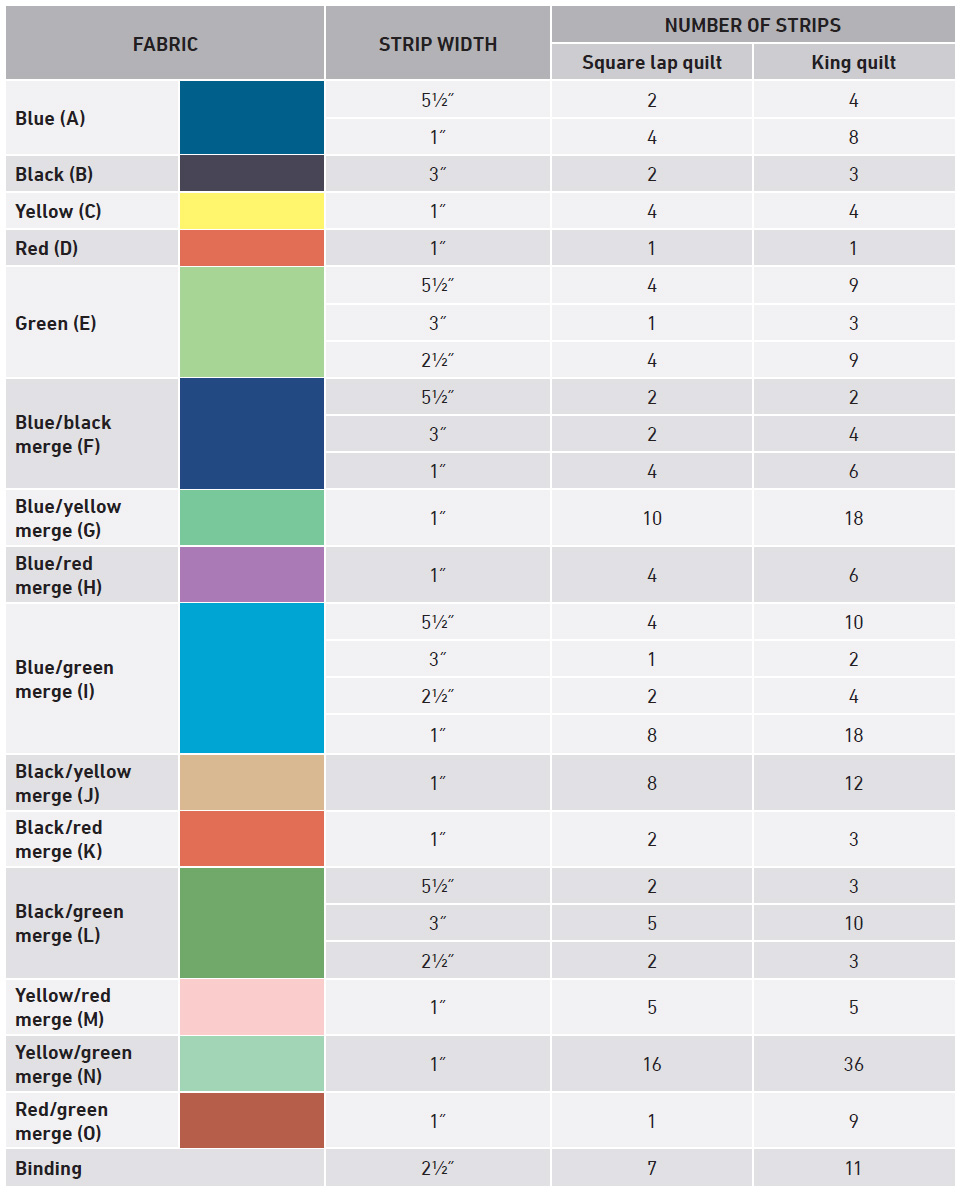
Making the Quilt
Triplets and Septets
Refer to the following lists to make strip sets from three fabrics for triple-strip sets or from seven fabrics for seven-strip sets. From the strip sets, subcut triplets and septets.
Maitland has a group of small strips, so instead of a triplet there is a septet, cut from a seven-strip set for the warp, and a “multi-row” for the weft. The multi-row is made by sewing the septets together side to side instead of end to end, and this should reduce the amount of distortion that is possible when using such thin rows. I like to make the two (square lap quilt) or three (king quilt) multi-rows first because they are the most time-consuming part of this quilt construction.

Stitch Length Don’t forget to make your stitches smaller, since these strip sets will be subcut into segments. This is especially important for the seven-strip sets!
Triplets
TRIPLE-STRIP SET 1
Make 4 strip sets for the square lap quilt or 9 for the king quilt. Subcut triplets 1, 3, and 5.
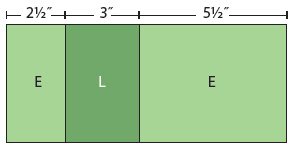
Square lap quilt
Triplet 3: 16 segments 5½˝ wide
Triplet 5: 4 segments 3˝ wide
Triplet 1: 16 segments 2½˝ wide
King quilt
Triplet 3: 36 segments 5½˝ wide
Triplet 5: 12 segments 3˝ wide
Triplet 1: 36 segments 2½˝ wide
TRIPLE-STRIP SET 2
Make 2 strip sets for the square lap quilt or 3 for the king quilt. Subcut triplet 2.
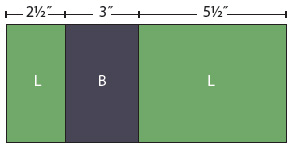
Square lap quilt
― Triplet 2: 16 segments 3˝ wide
King quilt
― Triplet 2: 36 segments 3˝ wide
TRIPLE-STRIP SET 3
Make 2 strip sets for the square lap quilt or 4 for the king quilt. Subcut triplet 4.
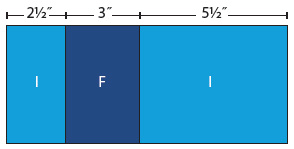
Square lap quilt
― Triplet 4: 8 segments 5½˝ wide
King quilt
― Triplet 4: 24 segments 5½˝ wide
TRIPLE-STRIP SET 4
Make 1 strip set for the square lap quilt or 3 for the king quilt. Subcut triplets 6, 8, and 10.
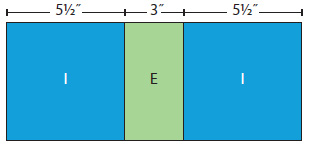
Square lap quilt
Triplet 8: 4 segments 5½˝ wide
Triplet 10: 1 segment 3˝ wide
Triplet 6: 4 segments 2½˝ wide
King quilt
Triplet 8: 12 segments 5½˝ wide
Triplet 10: 4 segments 3˝ wide
Triplet 6: 12 segments 2½˝ wide
TRIPLE-STRIP SET 5
Make 1 strip set for either quilt size. Subcut triplet 7.

Square lap quilt
― Triplet 7: 4 segments 3˝ wide
King quilt
― Triplet 7: 12 segments 3˝ wide
TRIPLE-STRIP SET 6
Make 1 strip set for the square lap quilt or 2 for the king quilt. Subcut triplet 9.
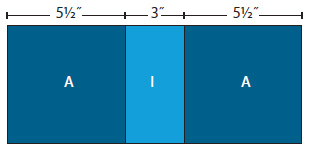
Square lap quilt
― Triplet 9: 2 segments 5½˝ wide
King quilt
― Triplet 9: 8 segments 5½˝ wide
Septets
Each strip that makes up the seven-strip sets is 1˝, finishing to ½˝. Create the seven-strip sets by first making 3 double-strip sets, sewing them together, and then adding the last strip.
SEVEN-STRIP SET 1
Make 4 strip sets for the square lap quilt or 9 for the king quilt. Subcut septets 1, 3, and 8.
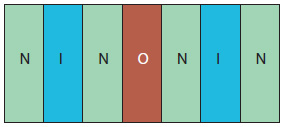
Square lap quilt
Septet 3: 16 segments 5½˝ wide
Septet 8: 4 segments 3˝ wide
Septet 1: 16 segments 2½˝ wide
King quilt
Septet 3: 36 segments 5½˝ wide
Septet 8: 12 segments 3˝ wide
Septet 1: 36 segments 2½˝ wide
SEVEN-STRIP SET 2
Make 2 strip sets for the square lap quilt or 3 for the king quilt. Subcut septet 2.
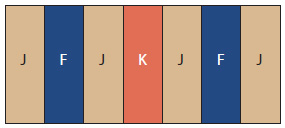
Square lap quilt
― Septet 2: 16 segments 3˝ wide
King quilt
― Septet 2: 36 segments 3˝ wide
SEVEN-STRIP SET 3
Make 1 strip set for either quilt size. Subcut septet 4.
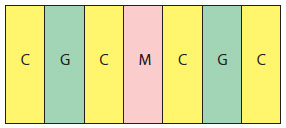
Square lap quilt
― Septet 4: 16 segments 1˝ wide
King quilt
― Septet 4: 36 segments 1˝ wide
SEVEN-STRIP SET 4
Make 2 strip sets for the square lap quilt or 4 for the king quilt. Subcut septets 5 and 7.

Square lap quilt
Septet 7: 8 segments 5½˝ wide
Septet 5: 8 segments 1˝ wide
King quilt
Septet 7: 24 segments 5½˝ wide
Septet 5: 18 segments 1˝ wide
SEVEN-STRIP SET 5
Make 1 strip set for either quilt size. Subcut septet 6.
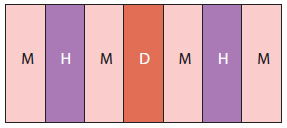
Square lap quilt
― Septet 6: 4 segments 1˝ wide
King quilt
― Septet 6: 9 segments 1˝ wide
Making the “Multi-Row”
Because the grouping of the thin strips might warp if sewn together as normal rows, you should sew these together first and then treat them as a single row, called a “multi-row.” Being careful to pin at each seam junction, sew the following septets together side to side (not end to end) in the order indicated below. To make it easy to keep them in the proper order, I like to sew them together in groups.

Sew the septets together side to side in the order indicated.
Making the Rows
Referring to the Row Types table for your quilt size (below), sew the triplets and septets together to make each type of row. To sew each row together, start with the piece listed at the left and add each segment in order from left to right. The numbers in each column refer to the triplet or septet number you made in Triplets and Septets. Refer to How to Build a Tartan Design, Step 5 for detailed instructions on how to assemble the rows.
Row Types—Square Lap Quilt
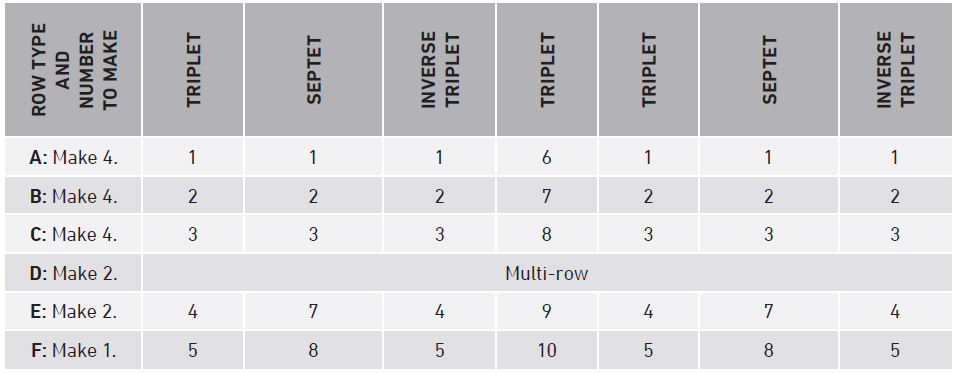
Row Types—King Quilt
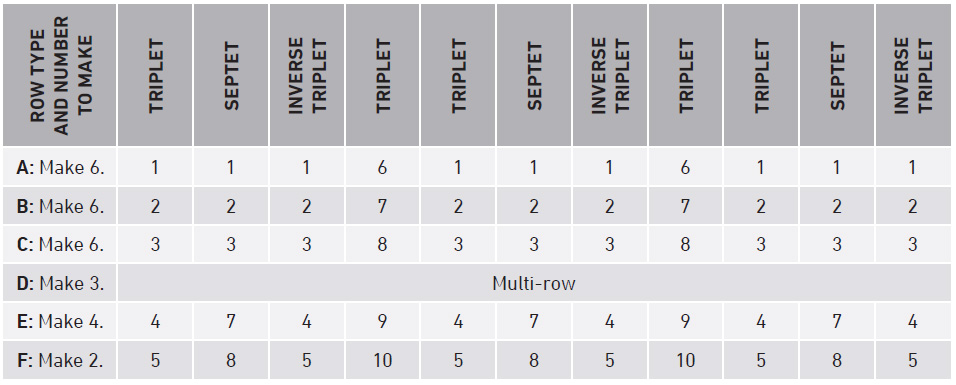
Quilt Assembly
Referring to the quilt assembly diagram, sew the row types together in the indicated order to complete the quilt top. Press the seam allowances of each row in the opposite direction from adjacent rows. Pin at each and every seam intersection.
